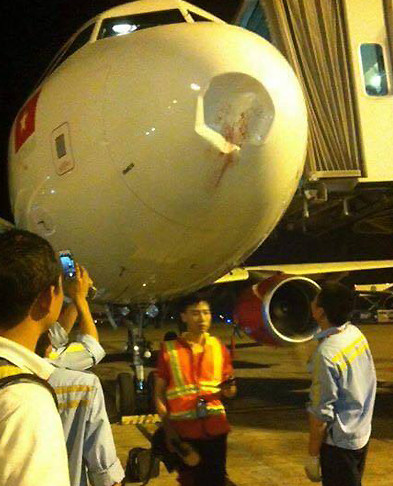Scientific explanation for the case of birds colliding with aircraft causing serious damage
On the evening of September 30, an Airbus plane landed in Noi Bai (Hanoi) in the condition of a distorted nose, forced to stop mining for repairs. According to Vietjet Air, A320 number VN-A650 from Buon Ma Thuot to Hanoi, landed at 19h22 on September 30, was hit by birds. The airline must stop operating aircraft to repair the dented head. So, why can birds cause such heavy damage? Let's find out with us.
Solving the problem caused by birds hitting the plane caused heavy damage
The plane crashed must take place every day around the world, but not every incident causes an accident. Since 1988 more than 200 people have died in animal-related plane accidents, causing more than $ 600 million in damages each year. In the United States alone, the Air Force commander has averaged more than 5,000 collisions between aircraft and birds on the territory every year.

Vietjet Air image is dented by the bird.
Theoretically large aircraft can continue to fly after colliding with birds weighing up to 2kg. However, up to 36 species of birds in North America have a much larger average weight, while even small stone birds can damage the aircraft's powerful engine.The bigger the speed difference between aircraft and birds, the more intimidating the impact of the collision with the aircraft. The weight of the bird is also a factor, but the speed difference has a bigger role. A flock of birds will become more dangerous if they hit the plane many times.
Dale Oderman, a professor of aviation engineering at Purdue University, said birds are a major danger to airplanes, especially during takeoff . 'The geese and the big birds are more terrifying than small birds. When birds hit a plane, they can be sucked into the engine and break the propeller. The broken wing was sucked deep into the engine and damaged other parts , 'he said. To cope with the danger of stalking from animals, airports apply various measures to minimize the risk of collisions between aircraft and birds. For example, people do not plant many trees near the airport because birds can nest or rest on trees.

Oderman took an example and calculated based on the theory as follows:
Suppose an average 1kg pigeon confronts a Boeing 747 taking off at a speed of about 330km / h or 92m / s. We assume that the aircraft is not moving in comparison with the pigeon, at this time the takeoff speed of the aircraft is the relative speed of 2 objects or the pigeon is flying at 92m / s. .
From there, we can calculate the kinetic energy of the bird according to the formula:
Kinetic energy = 0.2 x mass x movement speed ^ 2 = 0.5 x 1 x 92 ^ 2 = 4232 Jun.
Then, suppose that after the collision, the bird dented the plane with a depth of 5cm at the point of impact, at which point it was possible to calculate the force of the bird that this area absorbed. Here, the degree of the tip of the plane is the distance traveled by the impact point:
Luc absorbed = Bird's kinetic energy: Depth of dented area = 4232: 0.05 = 84640 Newton.
Or the plane has absorbed a force equivalent to the weight of an object with a volume of up to 8464kg.
Next, we calculate the pressure that the aircraft head suffered when it collided. Here, we default to the impact area as one half of the sphere with a 5cm radius (with the center of the collision point) . Since then, we calculated the area of the area on the dented plane head:
Area of collision area = 0.5 x 4 x 3.14 x 0.05 ^ 2 = 0.0157 square meters.
Finally, we calculate the pressure that the plane head must bear, the force of the main force is absorbed by the aircraft:
Pressure = Impact force: Collision area = 84640: 0.0157 = 5391082.8 pascal.
In addition, Mr. Oderman said the transport planes are similar to the Boeing 747 designed to withstand an average pressure of 7300 pascal, ie a pigeon in the above example. into an extremely dangerous object for aircraft including the Airbus A320 mentioned above from the beginning of the article.
- Avoiding birds attacking aircraft
- Use prairie grass to protect aircraft
- Pig birds call for death: Reasoning on a scientific basis
- Why can birds drop planes?
- When the real bird throws down, the iron bird
- Future aircraft fly in flocks like birds
- 5 natural phenomena make aircraft vulnerable to accidents
- Scientific explanation for the phenomenon of
- The reason birds don't crash into each other when flying
- Birds never ... fly
- Learn about the most popular Airbus A320 aircraft in the world
- Positioning birds helps reduce aviation accidents
 'Fine laughs' - Scary and painful torture in ancient times
'Fine laughs' - Scary and painful torture in ancient times The sequence of numbers 142857 of the Egyptian pyramids is known as the strangest number in the world - Why?
The sequence of numbers 142857 of the Egyptian pyramids is known as the strangest number in the world - Why? History of the iron
History of the iron What is alum?
What is alum?